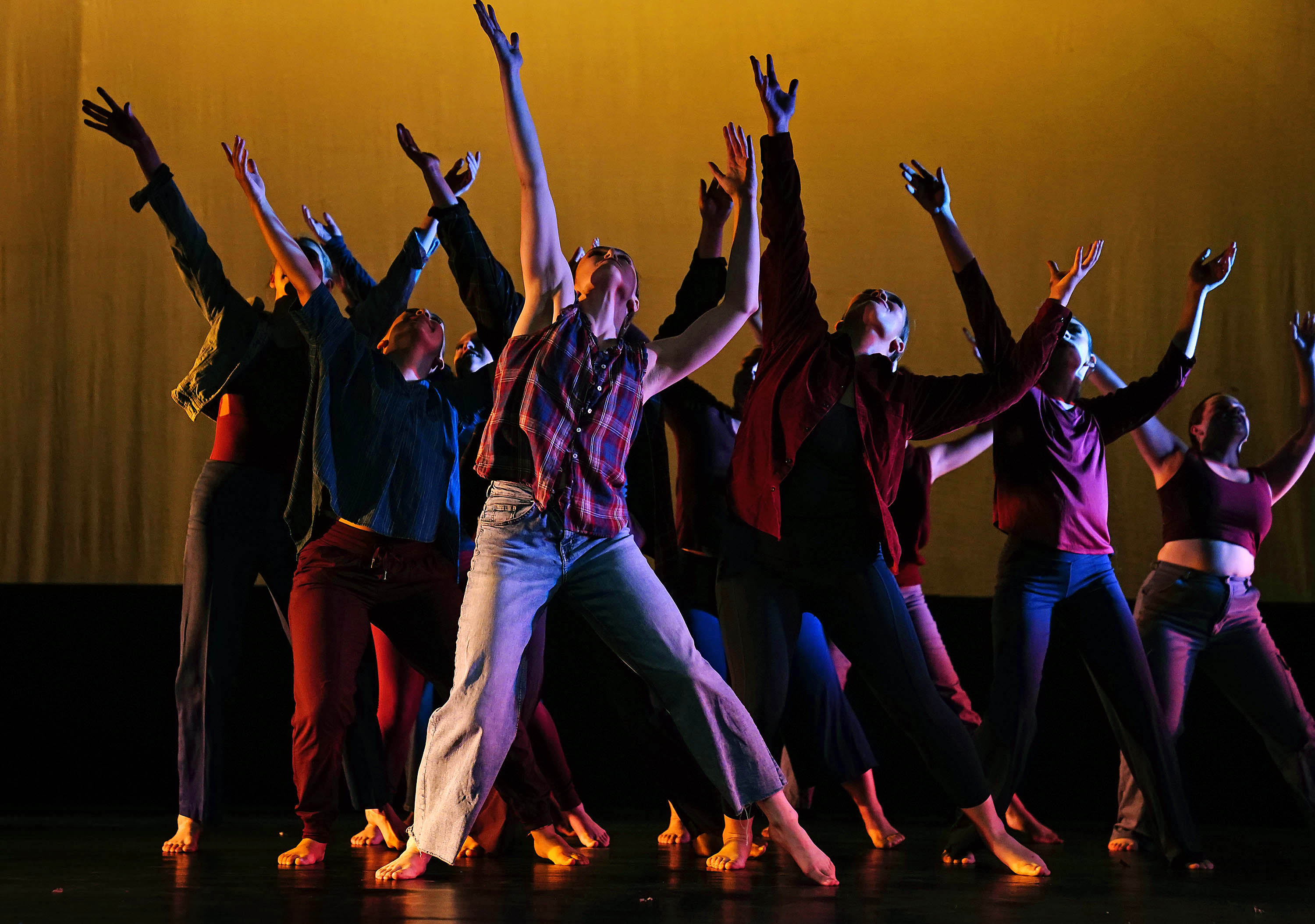
By Lana Sweeten-Shults
GCU News Bureau
Amber Strunk won’t forget the day scientists supplied the soundtrack to the silent movie of astronomy.
On Sept. 14, 2015, scientists made one of the most significant breakthroughs in physics in the past century. They “heard” two black holes colliding 1.3 billion light years away. The cataclysmic cosmic yawp emanated from gravitational waves produced by that megacrash. It was the first time scientists had direct evidence that gravitational waves exist -- something Albert Einstein had only envisioned 100 years before in his theory of general relativity.
“I made everybody watch it (the video of the sound of the collision). I got chills,” said Strunk, outreach coordinator for the Laser Interferometer Gravitational-Wave Observatory in Hanford, Wash., in a talk organized by Grand Canyon University's Strategic Educational Alliances.
She not only spoke about that scientific breakthrough but how she got her job at LIGO and how students also can get a job in the sciences.
Strunk zinged groundbreaking scientific concepts in a breath-consuming sprint for College of Science, Engineering and Technology students, telling them about the “chirp” heard ’round the world -- and the engineering marvel called LIGO that detected it.
A physics teacher at the time, Strunk shared this landmark event with her students, amazed by the “pretty squiggly lines" on the screen -- graphs of those gravitational waves. Her students did not share her excitement.

But those graphs and that chirp did what scientists haven't been able to do in 100 years: prove Einstein's vision of the universe.
“What he said is space and time are connected together and when you stick things in spacetime, they warp it. … A lot of people talk about the fabric of spacetime. You put a mass on it, and you get this divot,” Strunk said.
In Einstein's theory, a disturbance could cause spacetime to stretch, shrink or spawn waves, just as a rock might send ripples through a pond or a mattress might deform under a body.
The detection of this gravitational wave also confirmed Einstein’s theory of the nature of black holes as bottomless gravitational pits from which not even light could escape.
“Einstein predicted these gravitational waves in 1915,” Strunk said. “He thought they were an algebraic mistake at first. It took him two or three years to prove to himself that, no, they’re real. But you’re not going to find them.”
He was wrong.
The waves -- and their amplified sound -- were detected by LIGO, the world’s largest gravitational wave observatory, which actually is comprised of two massive laser interferometers 1,900 miles apart -- one in Hanford and the other in Livingston, La.
“Here’s why I got so excited. Look at these two waves. You guys have been in physics lab,” Strunk said. “... Everybody gets wildly different answers, right? But, in two different rooms 3,000 kilometers apart, they (LIGO Hanford and LIGO Livingston) detected the exact same wave. That’s amazing.”
Those squiggly lines represented two black holes, one 29 times as massive as the sun and the other 36 times as massive. They twirled around each other, 250 times per second toward the end, before finally smashing together to form a single black hole equal in mass to 62 suns.
“That’s what you can get when you understand what those pretty, squiggly lines can tell you,” Strunk said.
A star (LIGO) is born

In 1975, Caltech physicist Kip Thorne and MIT physicist Rainer Weiss started to talk about how to search for gravitational waves and test Einstein's general relativity theory.
Both started gravitational wave programs at their respective schools (and Thorne recruited Dr. Ronald Drever at Caltech to join in the effort). By 1984, the National Science Foundation, which funds LIGO (it's NSF's most ambitious project), asked the teams to merge.
The first version of LIGO launched in 2000. Then, in 2010, scientists rebuilt the system to make it more sensitive.
Advanced LIGO, Strunk said, is an engineering marvel.
The observatory, jointly operated by Caltech and MIT, is unlike other such facilities, which tend to be round and house enormous telescopes to detect light from the stars. LIGO is different in that it is designed to detect, not light, but gravitational waves.
Each LIGO detector includes two 2.5-mile long, 1.2 meter-diameter steel tubes in an “L” shape. The perpendicular arms are enveloped by 10-feet-wide, 12-feet-tall concrete enclosures that protect the tubes. Within the tubes, well, you won’t find anything but a vacuum chamber of empty space.
“All the air we pull out of the tubes could fill 3 million footballs,” Strunk said.
Mirrors that cost $250,000 each hang by glass fibers at the end of each arm. Those super strong fibers suspend the mirrors as pendulums, which helps reduce vibration. The mirrors are so sensitive that finger oils could cause microfractures that could, in turn, cause the mirrors to shatter, and a dust speck could cause high absorption spots that would ruin the mirror.
“Why in the world would you suspend a $250,000 mirror that would break because of the oil on your finger? It sounds exceedingly dumb," she said. "… The reason you do it is because every single vibration you can possibly think of causes us a problem, from trucks on a highway to ... the vibration of the atoms in the wires.
“It’s really crazy what we have to do to make this work. But here’s the cool thing: It works.”
Seeing something different
Scientists detect gravitational waves by looking for changes in the length of the detectors' arms. A gravitational wave will push and pull the arms and change the length of the tunnel by less than the width of a proton.

So far, LIGO has detected six gravitational waves.
On Aug. 17, 2017, LIGO and a sister gravitational wave observatory, the Advanced Virgo Detector near Pisa, Italy, “saw something different than we’d seen before.”
The LIGO scientists -- they not only work in the U.S. but in facilities around he world -- discovered that the Fermi Gamma-Ray Space Telescope detected a gamma ray burst from the same portion of sky 1.6 seconds after the gravitational wave detection.
With help from Virgo, they were able to help astronomers narrow their search from 1,200 square degrees to 30 square degrees. "We were able to go from billions of galaxies to look at to 50," Strunk said.
What they were witnessing was the collision of neutron stars.
Strunk pointed to a black dot on the screen in her presentation: “Aren’t you really excited about that black dot? … It’s the most cool thing that has happened to astronomy since the telescope because it’s not a little black dot. Every color of light came from that. From this event, we literally saw every single part of the electromagnetic spectrum.”
Just as cool is that, while gamma rays are detected all the time, “For the first time ever, we were able to say, ‘What caused your gamma ray burst was two neutron stars colliding.'"
Brand new science
The collision and merger of two neutron stars -- a kilonova -- is how scientists now explain where some of the universe’s elements come from. Scientists have agreed that elements come from stars, but that only works up until iron. Some elements beyond iron are created in supernovas, but that still doesn’t account for gold or platinum, for example. That's where kilonovas come in.
“That’s brand new science," said Strunk, who's still in wonder at this new way of looking at the universe, as is the scientific community. LIGO's founders -- Thorne, Weiss and Caltech's Barry C. Barish -- won the 2017 Nobel Prize in Physics. “For all of human existence, what we have done is looked to the sky with our eyes. … We’ve been watching a silent movie forever, and now we’ve got a soundtrack.”
Strunk paused to tell the story about how she got her job at LIGO. She dropped out of her Ph.D. program after having two children and said she felt like a failure: "I realized that bump in the road was a bump in the road, and I want to make sure you realize that, as well," she said. She never thought she would be hired there and wasn't going to apply, but with encouragement from friends, she did. As it turns out, they weren't looking for a Ph.D. They were looking for an educator with strong communications skills -- someone like Strunk.
She told students that many scientists at LIGO are not doctors and that you can get a science job with a bachelor's degree.
Also, she advised students to follow the Humans of LIGO blog to learn more about the people who work there, and she told students to follow scientists on Twitter who are doing work they might want to do. "They will tweet out information about internships ... about jobs," she said, then reflected on what's next for LIGO: "We have solved two longstanding mysteries in astronomy," she said. "And that’s just the start.”
GCU senior writer Lana Sweeten-Shults can be reached at lana.sweeten-shults@gcu.edu or at (602) 639-7901. Follow her on Twitter @LanaSweetenShul.
****
Related content:
GCU Today: "Dynamic STEM Duo' kicks off webinar series"
LIGO lab Caltech-MIT: Two black holes merge into one
LIGO Lab Caltech-MIT: The sound of two black holes colliding
New York Times: "Gravitational waves detected, confirming Einstein's theory"



















